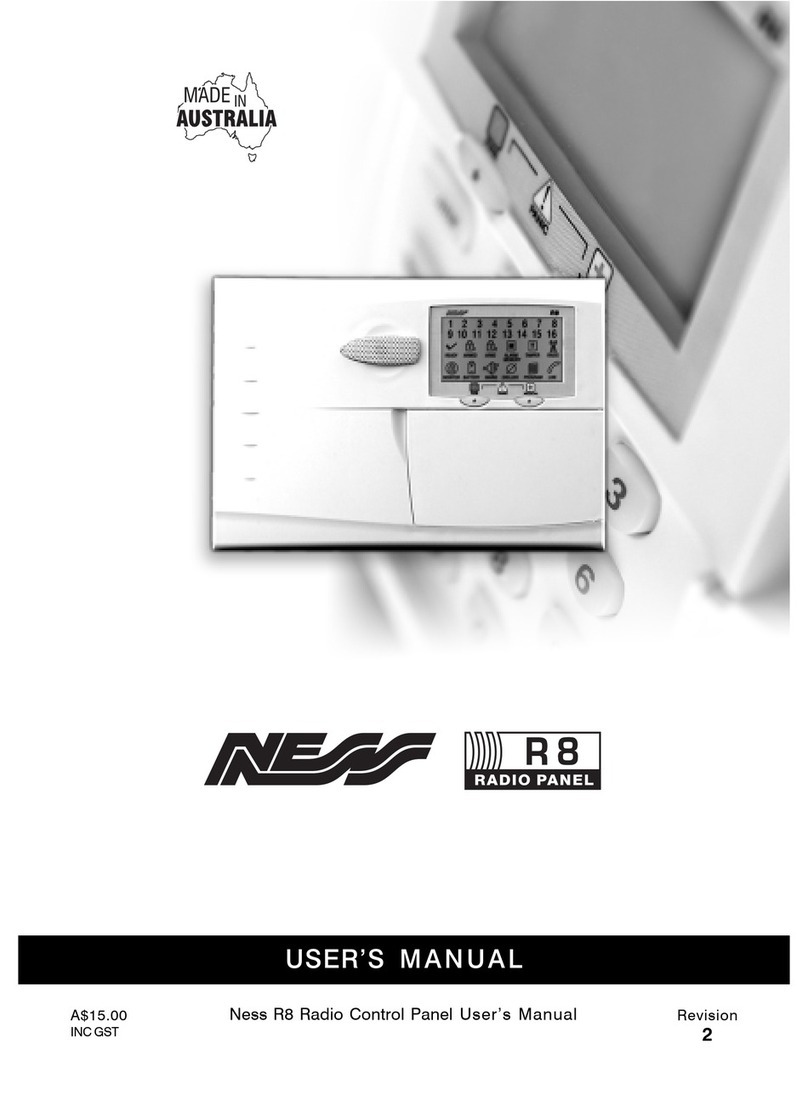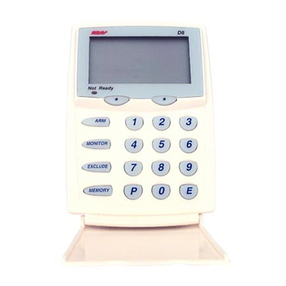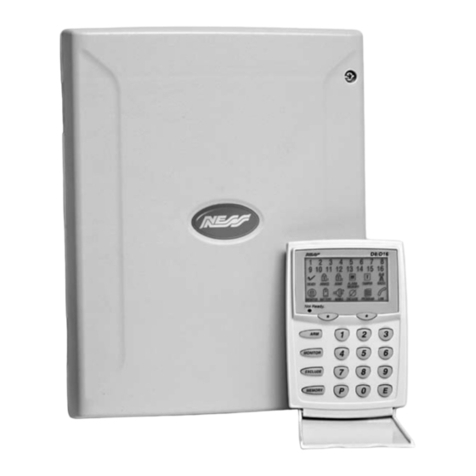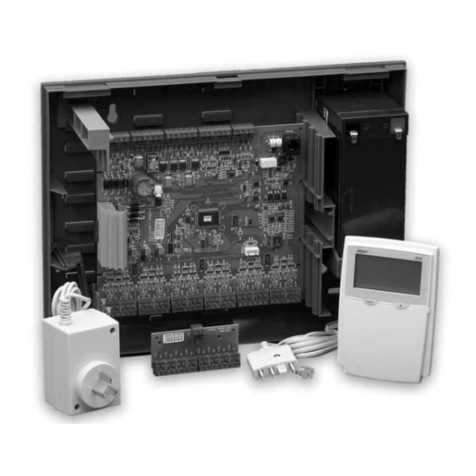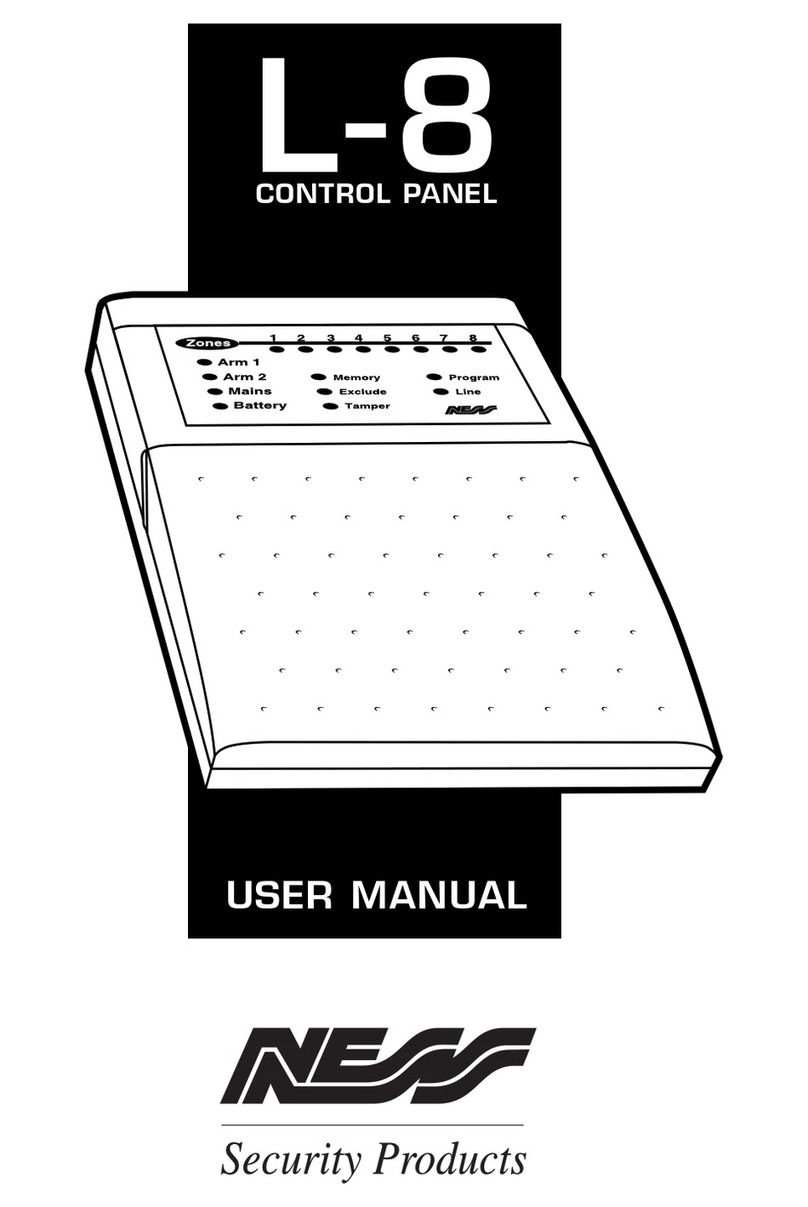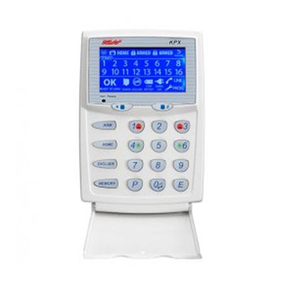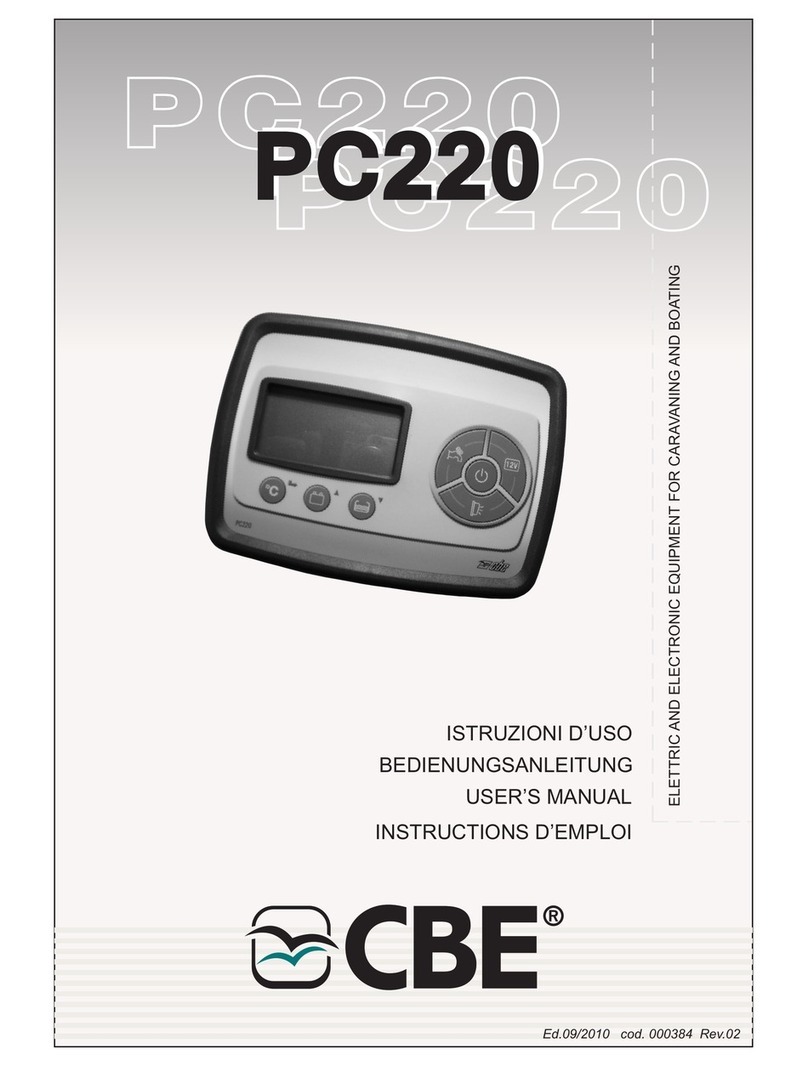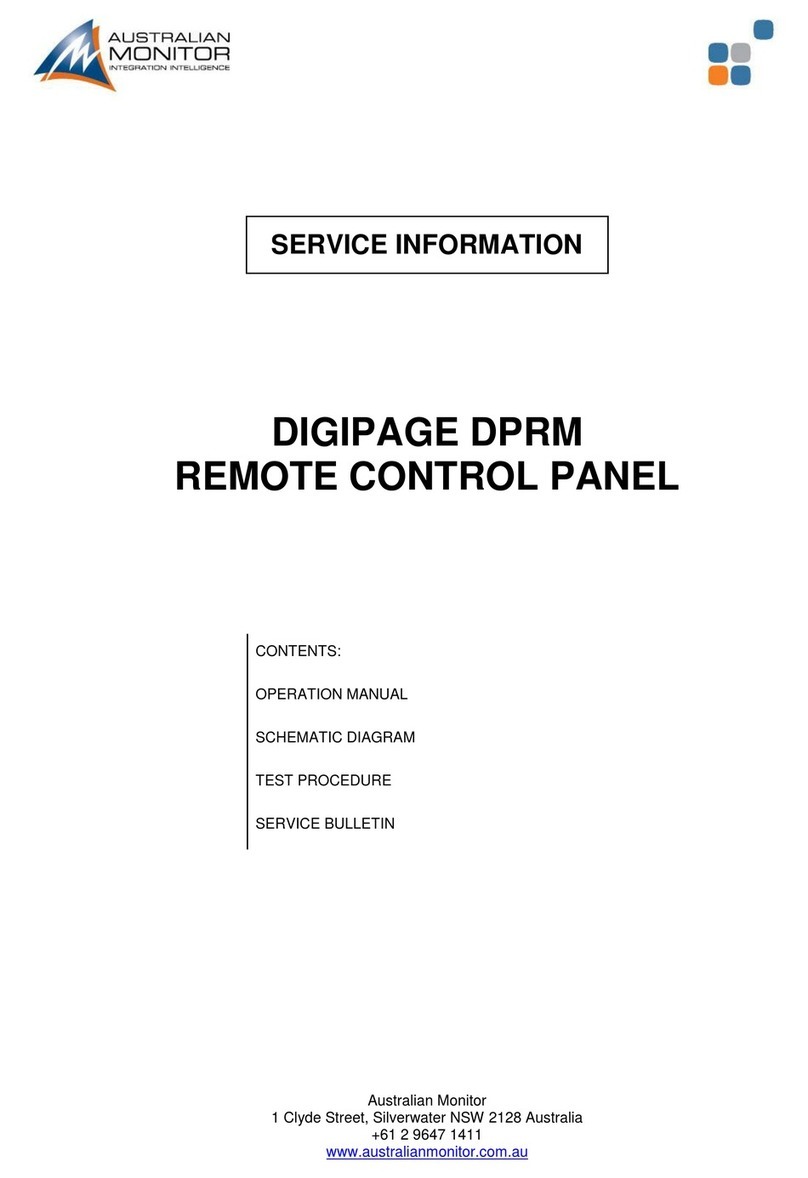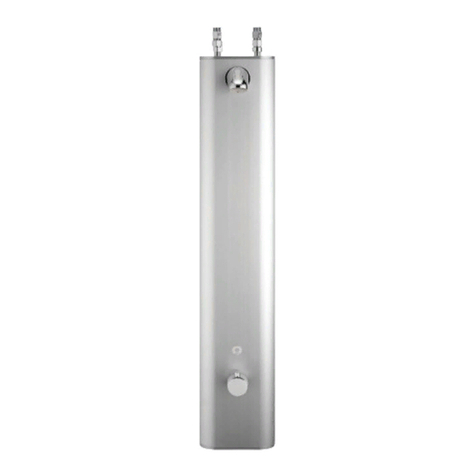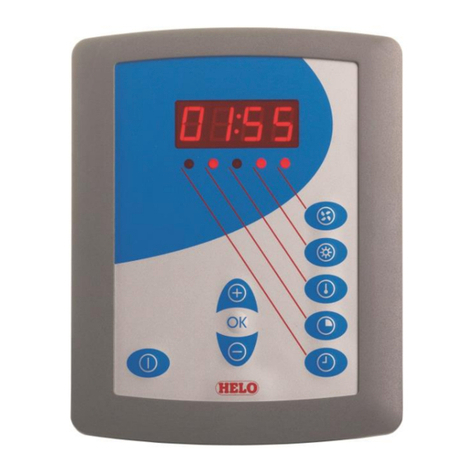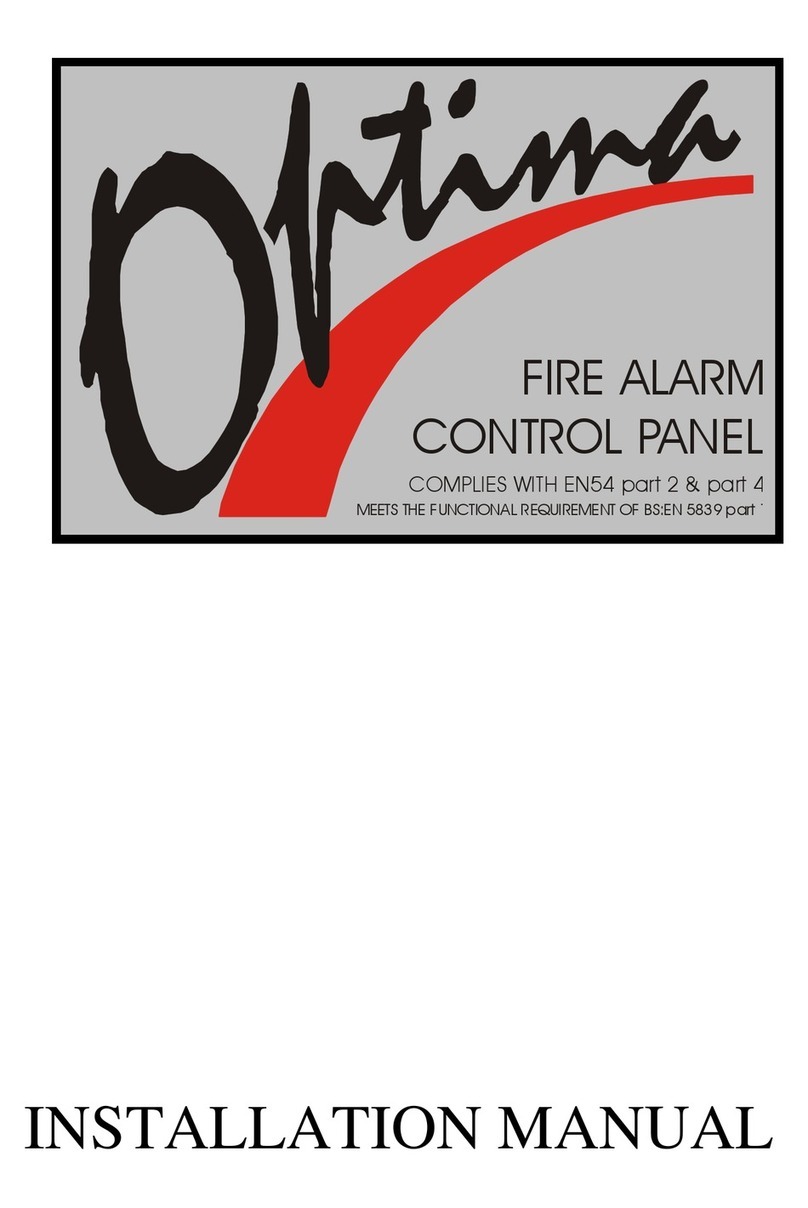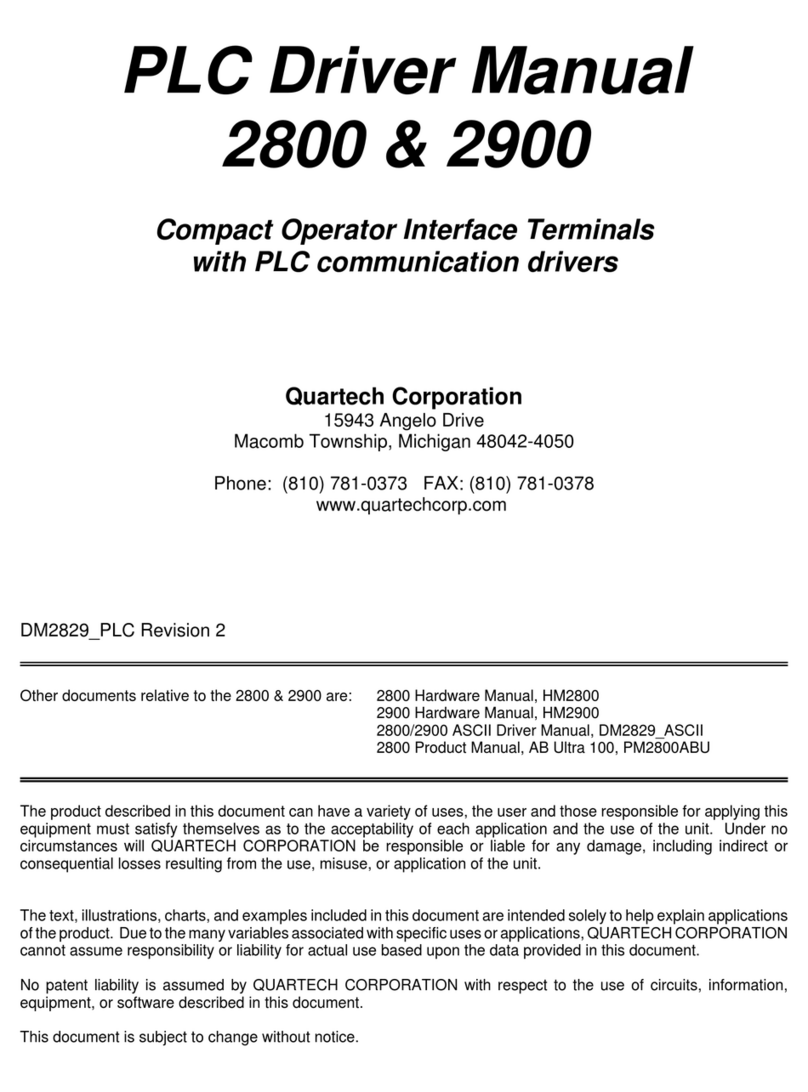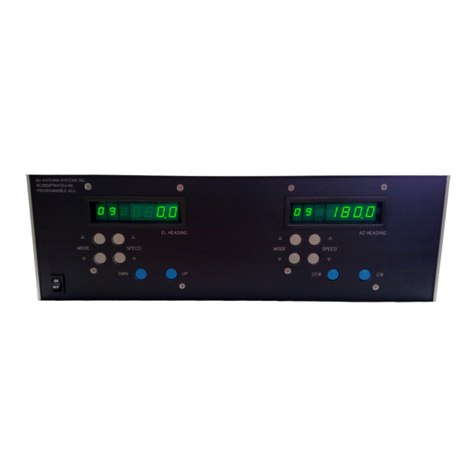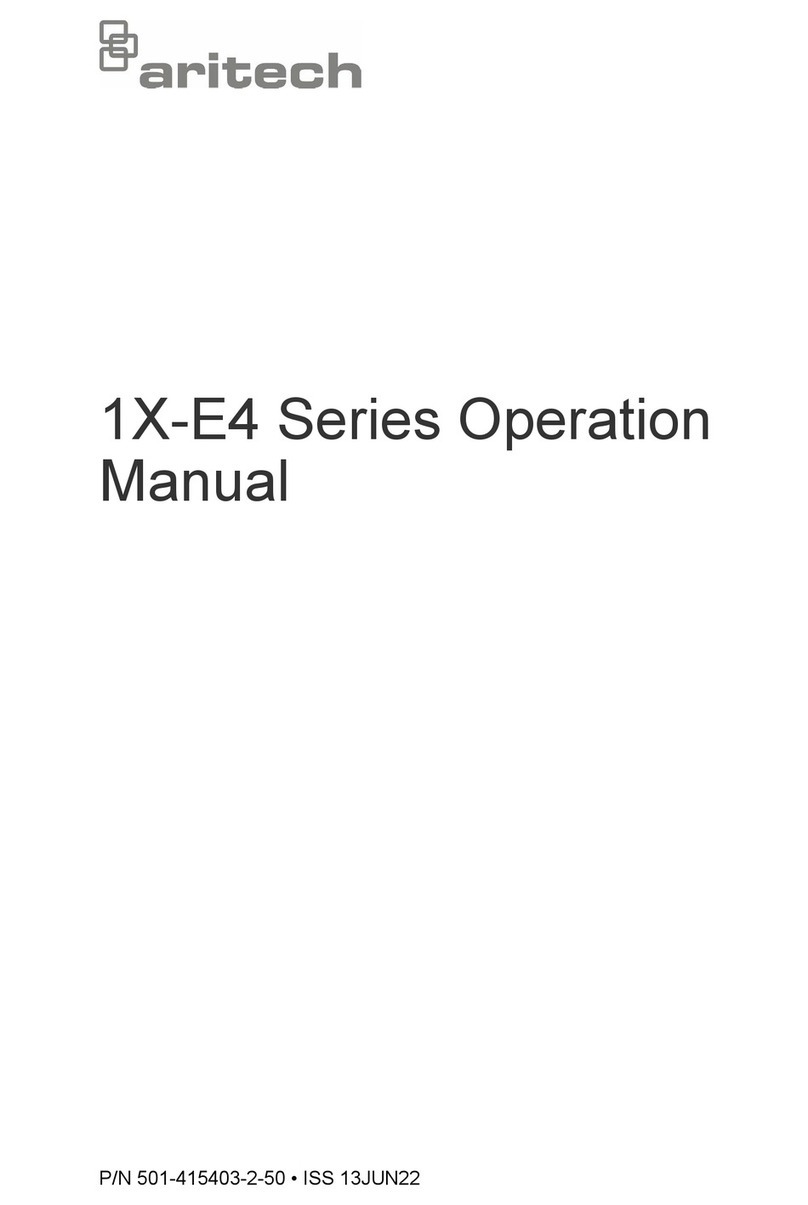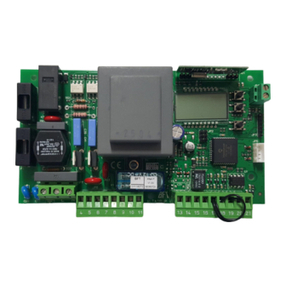Ness D-8 Assembly instructions

NESS D8 CONTROL PANEL INSTALLATION & PROGRAMMING MANUAL
A$15.00
INC GST Revision 4.7
CONTROL PANEL AND DIALLER
D8

“Australia’s largest
designer and
manufacturer of
high quality security
products”
D8 V4.7
INSTALLER MANUAL
Revision 4.7
June 2003
Document Part Number: 890–265
For product:
100–191 D8 LED Control Panel (V4.7)
100–688 D8 LCD Control Panel (V4.7)
© 2003 Ness Security Products Pty Ltd ABN 28 069 984 372
D8 V4 installer rev4.7 pmo040603
Specifications may change without notice.
NESS SECURITY PRODUCTS
TELECOMMUNICATIONS COMPLIANCE
Australian Communications Authority
HEAD OFFICE:
Ness Security Products Pty Ltd
ABN 28 069 984 372
4 / 167 Prospect Hwy
Seven Hills NSW 2147 Australia
Ph +61 2 8825 9222 Fax +61 2 9674 2520
SYDNEY:
Ph 02 8825 9222 Fax 02 9674 2520
MELBOURNE:
Ph 03 9878 1022 Fax 03 9878 4257
BRISBANE:
Ph 07 3343 7744 Fax 07 3849 4883
PERTH:
Ph 08 9328 2511 Fax 08 9227 7073
ADELAIDE (AQUAVIA CONTROLS)
Ph 08 8277 7255 Fax 08 8276-3028
NEW ZEALAND (NFS)
Ph +64 9 573 0401 Fax +64 9 573 0402
HONG KONG:
Ph +852 2721 8097 Fax +852 2721 7465
WWW.NESS.COM.AU

CONTENTS
Ness D8 features, specifications, packing list.............. 4
D8 revision history ........................................................ 5
CONNECTION DIAGRAM.......................................... 6
Wiring examples ........................................................... 7
Installation procedures ................................................. 8
Inputs, Outputs described ........................................ 8, 9
Keypad ........................................................................ 10
OPERATION SUMMARY .......................................... 11
HOW TO PROGRAM
Quick start Programming............................................ 12
How to enter Program Mode ...................................... 13
Program mode levels ................................................. 13
PROGRAMMING OPTIONS
USER CODES .......................................................... 14
Timers.......................................................................... 15
Vibration Sensitivity..................................................... 16
Zone Assignment .................................................. 17–19
TEMPORARY DAY ZONES
(New Feature, D8 v4.6 onwards)
Assigning Day Zones.................................................. 19
Temporary Day Zones operation ................................ 19
Temporary Day Zones operation summary................ 11
AREA PARTITIONING........................................ 20–21
Zone To Output Mapping...................................... 22–23
Various Options..................................................... 24–25
Tamper/Keypad Panic Output Mapping ..................... 26
System Operation Shortcuts ...................................... 27
MONITOR MODE OUTPUT MAPPING.................... 28
Day mode output mapping......................................... 28
Miscellaneous Options ............................................... 29
SUPERVISED RADIO ZONES ................................. 31
Supervision time ......................................................... 31
Radio Supervision Alerts....................................... 32–33
Misc. options 1...................................................... 34–35
Misc. options 2...................................................... 36–37
DIALLER OPTIONS
Telephone Numbers 1 & 2 .......................................... 38
Account Number 1 & 2 ............................................... 38
Telephone Number 3 – Test Calls ............................... 39
Telephone Number 4 – Callback ................................ 39
Follow me Telephone Number.................................... 39
Report zone alarms................................................. 40
Report zone restorals.................................................. 40
Report multiple zone alarms....................................... 40
Account No.2 zones.................................................... 40
Report Miscellaneous alarms ..................................... 41
Report Miscellaneous Restorals ................................. 41
Restoral Reporting options ......................................... 41
Test Call Interval...................................................... 42
Time before Next test call ........................................... 42
Dialling Method ........................................................... 42
Disable Dialler ............................................................. 43
Contact ID format .................................................... 43
Audible DTMF format.................................................. 43
Audible Pulse format............................................... 43
Contact ID Reporting Codes ................................. 44
Alternate Dialling ......................................................... 45
Check for dial tone...................................................... 45
Number of Dialling Attempts....................................... 45
Area1 open/close reports ........................................... 46
Area2 open/close reports ........................................... 46
Siren Chirp on kiss-off ................................................ 46
Strobe Flash on kiss-off .............................................. 46
Forced Opening Report.............................................. 47
Delay Closing Report.................................................. 47
Manual Exclude Report............................................... 47
Auto Exclude Report................................................... 47
Enable Test Calls..................................................... 48
Mains Report Delay..................................................... 48
Listen-in to dialler........................................................ 48
Swinger Shutdown...................................................... 49
Line Fault Monitor ....................................................... 49
Line Fault to AUX2....................................................... 49
Remote access ........................................................... 50
Direct Connect ............................................................ 50
Remote access options ........................................ 50–51
Required Rings ........................................................... 52
FACTORY DEFAULTS
Clear Radio Devices.................................................... 53
Clear Memory.............................................................. 53
Clear Panel Options.................................................... 53
Clear User Codes........................................................ 53
RADIO OPTIONS
Radio Quick Start........................................................ 54
Ness Radio Interface................................................... 54
Signal strength meter.................................................. 54
Radio Devices, Operation........................................... 55
Radio Supervision, Defined ........................................ 55
Radio Device Programming.................................... 56
Radio Key Programming......................................... 57
REMOTE OPERATION
Audible Monitoring Operation ................................ 58
Remote Operation by Telephone ........................... 59
Ness Accessories........................................................ 60
Wireless Products ....................................................... 61
PROGRAMMING OPTIONS SUMMARY ............ 62,63
Installation Record ...................................................... 64

4NESS D8 (V4.7) CONTROL PANEL – INSTALLER MANUAL
NESS D8 CONTROL PANEL
FEATURES
• 8 Fully programmable zones
• Any combination of hardwire or
radio zones
• Full radio supervision
• Contact ID Dialler Format
• Ultra-Modern and Impact resistant
Housing
• Ness Audible Dialler Format
• "Follow Me" Audible Dialler Option
• Separate 24 Hour Tamper input
• Single or Double Trigger Zones
• Remote LED or LCD Keypads
(Max 3)
• Fully programmable via the
system Keypad – Eliminates the
need for expensive programmers
or Proms.
• Inbuilt Vibration Sensor Analyser
• All programming data is perma-
nently stored in a non-volatile
EEprom memory
• Windows based Up\Down load
Software allows remote program-
ming and event status
• True Dynamic Battery Test every
time the Panel is armed / dis-
armed and every hour
• Area Partitionable (2 Areas). Any
Zone can be programmed to any
area, as well as common areas
• Comes complete with an AC plug
pack and supports a 12V 7Ah bat-
tery to maintain systems security
under all power supply conditions
• Monitor Mode (Home Mode)
• Outputs are separately fused with
Automatic Reset Fuses
• Day Mode and Door Chime fea-
ture.
• 30 Event Memory
• Supports 8 Radio Devices (Radio
PIRs, Radio Reeds etc)
• Supports 14 Radio Keys
• All inputs and outputs are heavily
protected against lightning and
high voltage supply transients.
An earth terminal is provided for
extra protection
• 15 User Codes
• ‘Arm only’ codes can be pro-
grammed
• Programmable Inputs to activate
selectable Outputs
• Designed utilising the latest SMD
Technology
• Forced Arming Feature
• Simple to Program and Use.
SPECIFICATIONS
Box construction ................. 3mm Polycarbonate (equiv. 1.2mm mild steel)
Box Dimensions .................. 223W x 300H x 85D mm
Power Supply...................... 13.8V DC @ 800mA
Quiescent Current............... 80mA with 1 Keypad
Operating Voltage ............... 9.5V– 14V DC
Rechargeable Battery ......... 12 volt 7.0 Amp/hour, lead acid
Battery Charging current .... 350mA maximum, current limited
Dynamic Battery Test .......... Every hour and on arming 10.75V with a 5 amp load
Fuses................................... 2 Amp resettable / sirens & reset.
500mA resettable / 12 volt auxiliary outputs
200 mA resettable / strobe output
INPUTS................................ 8 x Zone inputs
2 x 24hr Tamper inputs
End of line resistor .............. 2200 Ohm
Remote Keypad input ......... Proprietary
Maximum Keypads ............. 3
J2 Header............................ Multi-pin connector for the Ness Radio Interface (100-200)
OUTPUTS
Siren .................................... On board siren driver. Timed output.
Maximum 3 x 8 Ohm horn speakers
Strobe.................................. 12V DC timed output. Maximum 2 x 1 Watt strobe lights
Reset ................................... 12V DC timed output. Maximum 3 x 12V piezo screamers
Equipment power output .... 13.8V DC output for powering detectors and other equipment.
Maximum 500mA.
J3 Header............................ Multi-pin connector provides the outputs AUX1, AUX2, ARM1,
ARM2, 12V DC.
PACKING LIST
1 D8 main board
1 D8 housing
1 Ness LED keypad (100-192) or...
Ness LCD keypad (100-667)
1 17VAC plug pack
1 12V 7Ah battery (optional)
1 Dialler telephone lead
1 User manual
1 Installer manual
9 2.2K End Of Line resistors
1 Lead assembly for Battery
1 Lead assembly for Internal Tamper
1 Tamper bracket
1 Zone list label
2 Housing cover screws
2 Circuit board standoff
100–191 Ness D8 LED Control Panel
100–688 Ness D8 LCD Control Panel

5
NESS D8 (V4.7) CONTROL PANEL – INSTALLER MANUAL
D8 VERSION 4.7 (Aug 2003)
BUSY dial tone detection removed.
Allow remote operation with P86E 1E (Dialler Disable ON).
Up/download can still take place if Client Account Number (P72E,
P73E) is left at default value of 0000.
DTMF tone transmission OFF time reduced to match other NESS
diallers.
Improved central station tone detection.
Pulse output time reduced to 2.5 seconds for AUX1, AUX2 when
triggered by Radio Panic and Aux key.
Line Fail to Aux2 delay time reduced to 1 minute.
V4.6 (Released in D16 only Jan 2003)
New Feature - Temporary Day Zones. Enable or Disable Day
Zones from operating mode. Page 19.
Dialler Client Codes for transmission to a central station can be
entered in HEX. Page 39.
Mains fail alarm can be disabled Page 37.
Test report clock can be programmed to use the internal oscillator
for timing. Page 49.
Zones can be selected not to flash the Memory icon. Page 52.
RK4 Radio Key AUX button can be mapped to the D8 Aux2
output. Page 37.
CHANGES TO EXISTING PROGRAM OPTIONS
P63E 6E. Day Mode to Strobe becomes Day Mode to AUX2 if
P64E 2E is on.
P64E 2E, Brief Day Alarm is now defaulted OFF.
NEW PROGRAM OPTIONS
P69E 6E Disable mains fail alarm.
P69E 7E RK4 Radio Key AUX button toggles Aux2 output.
P69E 8E RK4 Radio Key AUX button pulses Aux2 output.
P89E 7E Internal clock timing.
P94E Select zones for no memory warning.
NEW FUNCTIONS.
P+E enters Temporary Day Zone Selection Mode. Accessed from
normal operating mode.
[Zone No.]+E selects Temporary Day Zones when in Temporary
Day Zone Selection Mode.
0+E Enables or disables Day Mode. Accessed from normal
operating mode.
EExits Temporary Day Zone Selection Mode.
D8 VERSION 4.5 (July 2002)
MONITOR ARMING BY RADIO KEY. Pressing the ON button twice
can now be used to enter MONITOR mode. This addition was done
to allow MONITOR mode arming using a RADIO keypad.
TEST CALL TIMING. When sending Test Calls, the time between
dialling attempts is increased to 60 minutes for the 2nd round
of dialling.
Arming from MONITOR Mode. Arm Only codes can arm the panel
directly from Monitor Mode. (Normal user codes can arm only
from the disarmed state.)
STROBE TIMEOUT. Strobe output will time out after 72 hours. This
stops continuous strobe operation when the alarmed premises
are vacant for long periods.
S/W VERSION. The software version of the panel is displayed in
Program mode by entering P99999999E (eight 9’s).
D8 VERSION 4 (Nov 2001)
RADIO
RADIO SUPERVISION. Radio supervision can be used with NESS
radio detectors that transmit periodic supervision signals.
Options added to either Toggle or Pulse Aux1 with the Radio
Panic key.
Option to have quieter siren chirps when arming/disarming with
key switch or radio keys.
ARMING
ARM ONLY CODES. User codes and radio Keys can now be
made to ARM ONLY.
Option for siren warning burst when arming with radio key and
a zone is unsealed.
Warning beeps timing extended by changing to Entry Delay 2
timer.
Monitor mode outputs are now selectable for both the 2 second
monitor mode and full monitor mode.
The outputs for Area 1 and Area 2 can now be made to pulse on
for 2 seconds. This makes them useful as Smoke Detector Reset
outputs by adding an external relay.
DIALLER
Aux 2 output option for telephone line fail.
Dialler sends a CANCEL report if there has been an alarm in full
monitor mode.
Dialler Listen-In has been added via the Siren output.
The Miscellaneous Alarm reporting options have been increased
to include reports such as Mains Fail, Battery Fail, radio tamper
reports and others now selectable).
Mains and Battery fail reports can be sent if required when using
the Audible format.
Closing reports can be delayed until end of exit time.
Manual and Auto Exclude reports can be disabled.
UP/DOWNLOAD
CallBack in Normal Mode and User Program mode is now optional
to allow up/download without having a fixed callback telephone
number.
The Up/Download Software is completely new and compatible
with Windows 9x/2K/XP.
HARDWARE
An option to select 3k3 EOL resistors for Zones. Default is 2k2.
A Tamper lead assembly is provided to connect internal tamper
switch to the Tamp header.
MISCELLANEOUS
Only include mains fail in alarm memory when the previous event
is not mains fail.
Fire Siren sound can be selected for 24hr zones. Handy for
Smoke Detectors.
Day mode does not latch zone alarms. The warnings are either
for 2secs or while the Day zone is unsealed.
Zone Exclude with User Code Entry only accepts zones (1-8) that
are in the AREAS that the User Code can arm.
In User Program Mode a Siren Test can be started by entering
77777777E (8 sevens) and Dialler Test Report can be initiated by
entering 66666666 ( 8 sixes).
Quiet siren sound option in Monitor mode, instead of the full
volume siren sound.
NESS D8 REVISION HISTORY

6NESS D8 (V4.7) CONTROL PANEL – INSTALLER MANUAL
J1
J2
RECEIVER
PROG
TAMP
BATTERY
NESS SECURITY PRODUCTS
105-220
TELEPHONE
HEATSINK
J3
AUX1
AUX2
ARM1
ARM2
12V
0V
TAMP
+12V
+12V
+12V
0V
Z8
C
Z7
Z6
C
Z5
Z4
C
Z2
Z3
C
Z1
0V
CLK
DAT
COM
KEYPAD
RESET
STR
SIREN
17V
AC
AC
EARTH
12V DC Power
for detectors, etc
12V DC Power
for detectors, etc
Up to 2 x Ness 12V Siren (100-172)
OR 3 x Top Hat Screamer (100-238)
Up to 2 x Strobe Light (NOI-300)
Up to 3 x Horn Speaker, 8 Ohm (NOI-110)
Ness 17V AC Plug Pack (840-029)
(Australia only)
17V AC (Red & Black)
EARTH (White)
+12V
CLK
DAT
NESS LCD Keypad
(100-667)
NESS LED Keypad
(100-192)
COM
NORMALLY OPEN
( DEVICESN.O.)
NORMALLY CLOSED
( DEVICESN.C.)
Zone
C
2K2
2K2
Zone
C
Zone 2
Zone 6
Zone 4
Zone 8
Zone 1
Zone 5
Zone 3
Zone 7
Maximum
3 keypads
ZONE CONNECTION
2K2 2K2 2K2 2K2
2K2 2K2 2K2 2K2
BOX TAMPER LEADS
(supplied)
BOX TAMPER SWITCH
N.C. Contacts (WHITE)
(supplied)
J2 CONNECTOR
(Optional)
NESS RADIO INTERFACE
J3 HEADER
Provides Open Collector
outputs as marked.
J1 LINK
&BOX TAMPER PROGRAM LINK
= Sealed, normal state
= Tamper alarm state
Power up with link off to enter
installer program mode
BATTERY LEADS
(supplied)
BATTERY CONNECTION
Connect 12V 7Ah
backup battery
“HEARTBEAT” LED
Constantly flashes
2K2
N.O TAMPER SWITCH
(761-002) Colour: BLACK
Supplied with Ness siren covers N.C TAMPER SWITCH (SWI920) Colour: WHITE
ALTERNATIVE TAMPER SWITCH WIRING
For N.C. Tamper Switches
2K2
TELEPHONE LEAD (Supplied)
Connect to Mode3 socket
The Tamper Switch
is readily identified being black in colour.
This tamper switch is now being to supplied
as standard with all Ness siren covers.
The Normally Open contacts are less prone
to flase activation in harsh climates.
NORMALLY OPEN The standard white
Tamper Switch is supplied with all Ness
control panels for box tamper.
NORMALLY CLOSED
NORMALLY OPEN
Tamper Switch
Part No: 761-002
Colour: Black
NORMALLY CLOSED
Tamper Switch
Part No: SWI920
Colour: White
TAMPER SWITCH IDENTIFICATION
D8 MAIN BOARD
NESS D8 CONNECTION DIAGRAM
© 2003 Ness Security Products

7
NESS D8 (V4.7) CONTROL PANEL – INSTALLER MANUAL
NESS D8
CONTROL
PANEL
TAMP
C
EXAMPLE 5 SIREN WIRING EXTERNAL INTERNAL
TAMP
C
STR
RESET
SIREN
Alernative 12V Sirens:
100-172 Ness 12V Internal Siren
NOI230 S110 12V Piezo Screamer
NOI240 S100 12V Piezo Screamer
100-238 Top Hat 12V Piezo Screamer
NOTE:
Ness Panel & Noise KITS are
supplied with the Ness Internal
Horn Speaker (100-171). This must
be connected to the SIREN output
in parallel with the Horn Speaker/s.
RED
RED
BLACK
BLACK
N.O TAMPER SWITCH
(761-002) Colour: BLACK
N.C TAMPER SWITCH
(SWI920) Colour: WHITE
ALTERNATIVE TAMPER SWITCH WIRING
For N.C. Tamper Switches
STROBE LIGHT
(NOI300)
The terminal block should
be mounted inside the
siren cover.
HORN
SPEAKER
(NOI110)
NESS D8
CONTROL
PANEL
NESS D8
CONTROL
PANEL
NESS D8
CONTROL
PANEL
0V
ALARM
TAMPER
N.C.
N.C.
+12V
N.C.
N.C.
NESS QUANTUM DETECTOR
(all models)
REED SWITCH
(N.C. contacts))
PANIC BUTTON
(N.O. contacts))
Zone [1~8]
Zone [1~8]
Zone [1~8]
Zone [1~8]
0V
C
+12V
0V
CC
+12V
0V
CC
+12V
2K2
2K2
NESS QUANTUM DETECTORS 4 WIRE CONNECTION
NESS D8
CONTROL
PANEL
0V
ALARM
TAMPER
N.C.
N.C.
+12V
N.C.
N.C.
NESS QUANTUM DETECTOR
(all models)
TAMP
0V
CC
C
+12V
2K2
2K2
EXAMPLE 2 NESS QUANTUM DETECTORS 6 WIRE CONNECTION
With Tamper
EXAMPLE 4
ANY N.C. DEVICE
ANY N.O. DEVICE
NC
NO
COM
EXAMPLE 1 EXAMPLE 3
2K2
2K2
2K2
SIREN IDENTIFICATION:
WHITE
BLACK -
WHITE
RED +
100-171
Ness Internal Horn Speaker.
(WHITE wires).
Connects to SIREN output.
100-172
Ness 12V Internal Siren.
(RED & BLACK wires).
Connects to RESET output.
NESS D8 CONNECTION EXAMPLES

8NESS D8 (V4.7) CONTROL PANEL – INSTALLER MANUAL
MONITORED ZONES
The Ness D8 has 10 separate monitored inputs.
• 8 x Fully programmable Zone inputs
• 2 x 24 hour Tamper input
ZONE INPUTS
Each zone input must be terminated with a 2K2 (2200
ohm) resistor as supplied. All inputs must be sealed with
an EOL resistor even if unused.
For wiring details of Keypads, Keyswitches, Panic Buttons
and Warning devices, see the wiring diagrams in the
wiring section of this manual.
TAMP – Tamper Input
The TAMP input must also be sealed with a 2K2 end of
line resistor. This input is always a 24hr input.
AC INPUT TERMINALS
These terminals are for the connection of the Ness
plugpack. The Ness D8 requires an AC transformer
rating of 1.4 Amps @ 17 V AC minimum. (Ness Part No.
POW215)
BATTERY
These terminals are for the connection of a sealed
lead-acid rechargeable 12Volt battery. Charge current is
limited to 350mA. The charge voltage is factory preset
at 13.8 V and does not need changing. Note: A 12 Volt
sealed lead acid rechargeable battery must be connected
for correct panel operation. Observe correct Polarity when
connecting the battery.
(Ness Part Number BAT210 12V 7Ah battery)
EARTH
For maximum protection against damage caused by
lightning strikes, connect a good earth to this terminal.
Alternatively use the Earth lead from the plug pack.
PROG/TAMP – Program Link & Internal Tamper Input
The PROG/TAMP link appears on the two pin J1 header.
The PROG/TAMP link has two purposes:
1. To enter Installer Program Mode on initial
power up. Power-up with the PROG link OFF. The
PROG link (or Box Tamper lead) must be ON in
operating mode.
2. Box Tamper. When used with the Internal Tamper
Lead (supplied), PROG/TAMP serves as the
24hr tamper input for the panel’s internal tamper
switch.
Replace the PROG Link with the Box Tamper
Lead. Connect the Internal Tamper Lead spade
terminals directly to the terminals of the internal
tamper switch (supplied). An end-of-line resistor is
NOT required on this input.
When PROG/TAMP is used for Internal Tamper,
powering up with the panel’s cover open will enter
Installer Program Mode.
INPUTS
The location of the main panel housing should be
in an area that is within the protected area of the
premises. A linen closet or cupboard are good
examples as these are generally located in the centre
of the Premises.
Positioning of the movement detectors should be
considered as the incorrect position may cause
unwanted alarms.
1. Unclip the lid by pushing in the directions of the arrows 1
and 2 as shown below.
2. Remove the Battery from the base.
3. Mount the rear panel housing to a secure location.
4. Insert the PCB stand-offs in the Panel and then plug the
circuit board onto the stand-offs.
5. Wire to the circuit board terminal blocks, as per the wiring
instructions shown in this installation manual.
6. Replace the Battery.
7. Insert the panel tamper bracket as shown at left.
8. Program the control panel as required
1
2
INSTALLING PCB STANDOFFS
& TAMPER BRACKET
HOW TO REMOVE THE LID
INSTALLATION

9
NESS D8 (V4.7) CONTROL PANEL – INSTALLER MANUAL
OUTPUTS
12 VOLT OUTPUT:
A regulated 13.8 VDC output is available to power detectors and other equipment. This
output is available from two sets of terminals marked +12V and 0V. The output is protected
by an Automatic Reset fuse.
A maximum load of 500mA may be connected to these terminals.
SIREN:
The on-board siren driver will drive a maximum of 3 x 8 ohm horn speakers (Ness Part No.
NOI110 or 100-171 Internal Siren). The output will reset at the end of siren time (P29E) or
whenever the panel is reset, whichever comes first. This output has an internal Resettable
fuse.
STR - Strobe:
A latched 12VDC output for connecting strobe lights. As of D8 Version 4.5,
this output will reset after 72 hours (3 days) or when the panel is disarmed.
(D8 versions prior to V4.5 allow indefinite strobe operation, until the panel is reset).
A maximum of 2 x 1 Watt Strobes (Ness Part No. NOI300) can be connected to this output.
The output is protected by an Automatic Reset fuse.
RESET:
A 12V DC output for connecting Ness sirens, piezo sirens or relays, etc. This output will reset
at the end of siren time (P29E) or whenever the panel is reset, whichever comes first.
A maximum of 3 x 12V piezo Sirens (Ness Part No. NOI240, NOI 230, 100-238) or 2 X Ness
Piezo (Part No 100-172) can be connected to this output. The output is protected by an
Automatic Reset fuse.
J3 HEADER
Aux1: This output is an open collector (switch negative) which can supply a maximum of 100mA.
Zone alarms may be selected to trigger this output by option P58E.
Aux2: This output is an open collector (switch negative) which can supply a maximum of 100mA.
Zone alarms may be selected to trigger this output by option P59E.
Arm1: This output is an open collector (switch negative) which can supply a maximum of
100mA. This output is turned on when Area 1 is armed.
Arm2: This output is an open collector (switch negative) which can supply a maximum of
100mA. This output is turned on when Area 2 is armed.
12V: 12V DC ouput for accessories. Maximum current draw 100mA.
0V: 12V ground.
OUTPUT FUSING
The 12V ouputs, Siren, Reset and Strobe outputs are protected by Automatic Reset electronic
fuses. These outputs will automatically reset once the overload is removed.
J3
OPEN COLLECTOR
OUTPUTS
AUX OUTPUTS
The D8 and D16 Aux1 and Aux2
outputs can now be driven by a
number of different conditions and
alarms.
The following is a summary of the
Aux1 and Aux2 program options
and conditions.
AUX1 CAN BE TRIGGERED BY:
• Any zone alarm if programmed by
option P58E. The output remains on
until the panel is reset/disarmed.
• A Radio Supervision alarm if option
P66E 5E is on. The output remains on
until the panel is reset/disarmed.
• Remotely by telephone.
• A Ness RK3 or RK4 Radio Key
PANIC button if options P68E 3E or
4E are on.
(if 3E is on, the output Toggles, if 4E
is on, the output Pulses. If both 3E &
4E are on, the output will Pulse).
• A Ness RK4 Radio Key AUX button
if options P68E 3E or 4E and 7E are
on.
AUX2 CAN BE TRIGGERED BY:
• Any zone alarm if programmed by
option P59E. The output remains on
until the panel is reset/disarmed.
• A Radio Supervision alarm if option
P66E 6E is on. The output remains on
until the panel is reset/disarmed.
• Remotely by telephone.
• A Ness RK4 Radio Key AUX button
if option P69E 7E or 8E are on.
(if 7E is on, the output Toggles, if 8E
is on, the output Pulses. If both 7E &
8E are on, the output will not work).
NOTE: Aux1 and Aux2 will both be
turned off by a Pulse on any other
output, (including siren/strobe).
For example, if either Aux output is
toggled on, the output will be turned
off by the Radio Key arm/disarm
strobe flash.
This makes it necessary to disable
all ‘pulsing’ outputs if toggled Aux
outputs are to work correctly.
BACKUP BATTERY
A properly charged battery MUST be installed to ensure the Siren, Strobe and Reset outputs
operate correctly.
SIREN LOAD
A maximum output of 2.0A continuous is available from the SIREN, and RESET outputs and
200mA from the STR output.
Recommended maximum power load:
3 x Horn speakers (SIREN output)
2 x Strobe lights (STR output)
2 x Ness Internal Sirens (100-172) (RESET output)
Note: (This assumes no more than 500mA is being drawn from the 12V device output).

10 NESS D8 (V4.7) CONTROL PANEL – INSTALLER MANUAL
KEYPAD
2
5
8
0
1
4
7
P
3
6
9
E
ARM
MONITOR
EXCLUDE
MEMORY
Not Ready
Backlit LCD
icon display
PANIC buttons
PANIC buttons
“Not Ready” light
The “Not Ready” light is on when the panel is not ready to Arm.
i.e, a zone is unsealed, there may still be movement in the
premises or a door or window left open
ARM button
ARM button MONITOR button
MONITOR button EXCLUDE button
EXCLUDE button
PROGRAM button
ENTER button
MEMORY button
MEMORY button
LED KEYPAD LCD KEYPAD
PROGRAM button
Protective flap not shown
Protective flap not shown
ENTER button
PANIC
ARM
1
4
7
0
2
5
8
ENTER
3
6
9
MONITOR
EXCLUDE
PROGRAM
PANICMEMORY
105mm 90mm
150mm
135mm
D8 KEYPADS
The Ness LED or LCD keypad
provides important visual and audible
indication of the system status and
is the main interface for controlling
the many powerful features of the D8
system.
DISPLAY TEST (LCD KEYPAD ONLY)
To display all the keypad icons press
and hold the button for at least
2 seconds. All the icons will be on
whilst the button is held down.
Display Test can be activated at any
time either in operating mode or any
program mode.
NUMBER OF KEYPADS (BOTH KEYPADS)
Up to 3 LED and/or LCD keypads
can be connected to the D8.
CABLE LENGTH (BOTH KEYPADS)
The maximum allowable cable
length is 100m (total cable length to
all keypads) .
NESS D816 LCD KEYPAD (100-667)
MEMORY MODE - EVENTS INDICATED BY KEYPAD LIGHTS:
LIGHT MEMORY EVENT
Zone lights 1–8 ....................... Zone alarm
(no lights) ...............................Panel Disarmed
ARMED................................... Panel Armed (or Area 1 Armed)
ARM2 .....................................Area 2 Armed
MAINS .................................... Mains power failure
BATTERY ................................Low Battery
TAMPER .................................Tamper alarm (Siren cover, panel etc)
EXCLUDE ................................Panic alarm
LINE .......................................Telephone line fail
RADIO, EXCLUDE .................... Radio Key Panic alarm
RADIO, BATTERY, ZONE ..........Radio Device battery low, (Device number is indicated by zone lights)
RADIO, BATTERY, ARM ........... Radio Key battery low, (Radio Key number is NOT indicated)
RADIO, TAMPER, ZONE ........... Radio Device tamper alarm (Device number is indicated by zone lights)
RADIO, MONITOR, ZONE ......... Radio Supervision fail (Device number is indicated by zone lights)
KEYPAD INSTALLATION
· Unclip the top half of the keypad housing
by pushing the top clips down with a small
screwdriver and pulling the housing forward.
· Screw the base of the keypad housing to the
wall using the 4 mounting holes provided.
· Bring the 4 connecting wires to the terminal
block on the PCB on the rear of the keypad
housing.
· Connect the wires to the screw terminals as
per the wiring diagram shown in this manual.
· Clip the top half onto the base by first engag-
ing the bottom clips and swinging the top
closed. Push hard to ensure the clips engage.
· Attach the Zone list label on the inside of the
lid.
Zone is sealed
Zone is unsealed, or Power fault
or System is Armed,
or phone line fault
Disarmed
Disarmed
Disarmed
Normal
Normal
Normal
Normal
Normal
Normal
Normal
Normal
Ready to Arm
Zone is unsealed
Ready to Arm
Armed (AREA 1)
Armed (AREA 2)
Monitor Mode
Memory Mode selected
Receiving radio signal
Dialler is on line
Indicates that a Radio Key or
other radio device has a
low battery
Phone line fault or
failure to communicate
User Program Mode
Not ready to Arm
Zone alarm
Monitor Mode
(
LED Keypad only)
Mains Power is off
The panel’s backup
battery is low
New alarms in memory
Zones are excluded
Tamper alarm
Installer Program Mode
ZONES 1-16
Not Ready
OFF ON FLASHING
KEYPAD ICON STATUS
KEYPAD ICON
DISPLAY
NESS D8 LED KEYPAD (100-192)

11
NESS D8 (V4.7) CONTROL PANEL – INSTALLER MANUAL
OPERATION SUMMARY
ARM
TEMPORARY DAY
ZONES
DISARM
MONITOR MODE
PANIC
KEYPAD DURESS
EXCLUDING ZONES
VIEW MEMORY
(Monitor Shortcut
must be ON, P62E 3E)
Press and hold for 4 seconds
(P68E 3E & 4E must be OFF)
Press OFF button twice within 4 seconds
or ON button twice within 4 seconds
P69E 5E must be ON
or
The panel must be in
a Disarmed state first.
To Disarm and/or reset
alarms.
The panel must be in
a Disarmed state first.*
The panel must be in
a Disarmed state first.*
P64E 2E must be on for
enable the use of
Temporary Day Zones.
* NOTE ON ARMING: Nor
Note: On the Ness LED keypad, the 'E' button is labelled 'ENTER' and the 'P' button is labelled 'PROGRAM'.
mal user codes can arm the panel only if it is fully disarmed first. User codes that are programmed to be Arm Only
codes can arm the panel from Monitor mode or from the disarmed state.
OPERATION KEYPAD RADIO KEY
To Disarm and report a Duress Alarm, add any of the digits 5, 6, 8 or 9 before the User Code
when Disarming. P75E1E must be enabled
Keypad Duress is factory
set for silent reporting
EXCLUDE + ENTER can only
be used when the panel is
disarmed.
EXCLUDE + CODE + ENTER
can be used when the panel
is armed or disarmed.
x2
x1
x1
x2
Hold
Press repeatedly to display the last 30 events
Both keys together
(Keypad Panic Shortcut
must be ON, P62E 4E)
or...
or... or...
[Zone No.]
[Zone No.]
[Zone No.]
[]5, 6, 8 or 9
[User Code]
[User Code]
[User Code]
[User Code]
(Arming Shortcut
must be ON, P62E 5E) or... [User Code]
Enter the zone numbers to be Excluded
To exit Exclude mode
To exit Memory mode
Enters Temporary Day Zone selection mode.
Enables/disables Temporary Day mode.
Select zone/s to be Temporary Day Zones.
Saves changes and exits Temporary Day Zone selection mode.
(Exclude Shortcut
must be ON, P62E 2E) or... [User Code]
(Memory Shortcut
must be ON, P62E 1E) or... [User Code]
View Memory can only be
used when the panel is
disarmed.

12
PROGRAMMING
NESS D8 (V4.7) CONTROL PANEL – INSTALLER MANUAL
QUICK START PROGRAMMING
Use one of these programming summaries for fast setup of your D8 as a Local,
Audible Monitored or Central Station Monitored system.
The control panel will be ready for use immediately.
QUICK START 1
LOCAL SYSTEM
Quick Start 1 shows you how to
change User Code 1 (the Master
Code).
By default, the dialler is disabled
until programmed.
1Enter User Program Mode Program Light is ON
2Selects the option for User Code 1
3Enter the new User Code Can be 3 to 6 digits long
4Enter the new User Code again
5To exit Program Mode
STEP
QUICK START 1 - step by step
DESCRIPTION COMMENT
Program light turns OFF
KEY STROKES
23
1
1 1
The code is displayed by the
keypad lights, followed by 3 beeps
new
The code is displayed by the
keypad lights, followed by 3 beeps
existing
QUICK START 2
AUDIBLE MONITORING
Quick Start 2 shows you how
to change User Code 1 (the
Master Code), enable Audible
Monitoring and program 1
telephone number. This will
enable the dialler to report
alarms to any telephone
including mobile phones.
QUICK START 2 - step by step
Enter User Program Mode
Enter Installer Program Mode
Program Light is ON
Program Light is FLASHING
Selects the option for User Code 1
Enter the new User Code Can be 3 to 6 digits long
Enter the new User Code again
At P86E, turns ON option 4
Selects the option for Telephone No.1
Enter the telephone number
Audible Monitoring enabled
Can be up to 15 digits long
To exit Program Mode
Program light turns OFF
KEY STROKES DESCRIPTION COMMENT
1
2
3
4
5
6
7
8
9
STEP
1 1
8 6 4
70
Up to 15 digits
23
1
0 0 0 0 0 0
The code is displayed by the
keypad lights, followed by 3 beeps
new
The code is displayed by the
keypad lights, followed by 3 beeps
existing
See page 58 for further information on the operation of Audible Monitoring.
72
QUICK START 3 - step by step
Enter User Program Mode
Enter Installer Program Mode
Program Light is ON
Program Light is FLASHING
Selects the option for User Code 1
Enter the new User Code Can be 3 to 6 digits long
Enter the new User Code again
At P86E, turns ON option 2
Selects the option for Telephone No.1
Enter the Telephone Number
Enter the Account Number
Central station Monitoring enabled
Existing Ph No (if any) displayed
Can be up to 15 digits long
Must be 4 digits
To exit Program Mode
Program light turns OFF
DESCRIPTION COMMENT
1
2
3
4
5
6
7
8
9
10
STEP
1
2
3
KEY STROKES
1 1
8 6 2
70
Up to 15 digits
23
1
0 0 0 0 0 0
The code is displayed by the
keypad lights, followed by 3 beeps
new
The code is displayed by the
keypad lights, followed by 3 beeps
existing
Option P86E 2E is ON by factory default. This option only needs to be turned ON if previously
programmed OFF.
Account Number to identify the premises - supplied by the Central Station
The tation’s receiver telephone number - supplied by the Central StationCentral S
QUICK START 3
CENTRAL STATION
MONITORING
Quick Start 3 shows you how
to change User Code 1 (the
Master Code), enable Central
Station Monitoring and program
one telephone number. This
will enable the dialler to report
alarms to a Central Station.
* Factory default Master Code is: 123
*Factory default Installer Code is: 000000
** User codes must not start with 0.

13
PROGRAMMING
NESS D8 (V4.7) CONTROL PANEL – INSTALLER MANUAL
[INSTALLER CODE]
Factory default Installer Code: 000000
[MASTER CODE]
Factory default Master Code: 123
USER PROGRAM Mode
INSTALLER PROGRAM Mode
NORMAL OPERATING Mode
Power up with Program Link OFF
(Usually on first time installation)
PROGRAM LIGHT IS FLASHING
PROGRAM LIGHT IS ON
PROGRAM LIGHT IS OFF
PROGRAM MODE LEVELS
TABLE 4. FLOW CHART
INSTALLER PROGRAM MODE
Installer Program Mode allows
access to ALL program options.
Note: The panel will remain in
Installer Program Mode indefinitely.
PROGRAM
PROGRAM
light
is FLASHING
USER PROGRAM MODE
User Program Mode allows the
owner to program:
• All User Codes
• Entry Exit Times
• Follow Me Telephone number
Note: The panel will automatically
drop out of User Program Mode to
Operating Mode if no keypad buttons
are pressed for 4 minutes.
PROGRAM
PROGRAM light
is ON
HOW TO ENTER PROGRAM MODE
FROM POWER UP
1. Power-up with the PROG link OFF.
(The PROG link (or Box Tamper lead) must be ON in Operating Mode).
USING KEYPAD
The panel must be Disarmed.
1. Press
[MASTER CODE]
The keypad will respond with 3 beeps
This is User Program Mode (PROGRAM light is ON).
2. Press
[INSTALLER CODE]
The keypad will respond with 3 beeps
This is Installer Program Mode (PROGRAM light is FLASHING).
HOW TO EXIT PROGRAM MODE
1. Press then
This is Operating Mode (PROGRAM light is OFF).
FACTORY DEFAULT
MASTER CODE: 123
INSTALLER CODE: 000000
PROGRAM button
3 beeps
Selects a program
option (address)
The current value
is displayed
The keypad lights or
icons will display the
current value
Enter new
data
3 beeps
ENTER button
ENTER button
2 Digit Option
(00 to 99)
Enter new value
using keys 0 - 9
KEY SEQUENCE
IN PROGRAM
MODE

14
PROGRAMMING
NESS D8 (V4.7) CONTROL PANEL – INSTALLER MANUAL
P11E – P25E
PROGRAM MODE LEVEL:
User, Installer, Remote by PC
FACTORY DEFAULT:
User Code 1: 123
Installer Code: 000000
All other codes: [blank]
NOTES:
• User Codes can be 3 to 6 digits in length.
• Codes beginning with 0 (zero) can be
programmed but they will not operate
the panel - this is an alternative method
for disabling user codes. The MEMORY
E function is recommended for deleting
user codes.
• All codes must be unique to each other.
Codes are rejected if already used. Some
codes that are similar to existing codes
may also be rejected.
• User Codes 2–15 can be programmed to
be ARM ONLY codes.
• When programming a code you must
enter it twice for verification.
• To clear all codes (except the Installer
Code), enter P98E in Installer Program
mode. See Page 53.
• Open/Close reports are identified by user
number when the control panel is base
station monitored.
INSTALLER CODE NOTES:
The function of the Installer Code is to
gain access to Installer Program Mode.
See Page 13, How To Enter Program
Mode.
See page 53, Programming The Installer
Code.
CODE OPTION No DESCRIPTION FACTORY
DEFAULT
User Code 1 P11E Master Code 123
(Keypad Code only)
User Code 2 P12E
2E
User Code 3 P13E
3E
User Code 4 P14E
4E
User Code 5 P15E
5E
User Code 6 P16E
6E
User Code 7 P17E
7E
User Code 8 P18E
8E
User Code 9 P19E
1E
User Code 10 P20E
2E
User Code 11 P21E
3E
User Code 12 P22E
4E
User Code 13 P23E
5E
User Code 14 P24E
6E
User Code 15 P25E
7E
Installer Code P99E Installer Code 000000
P09E
P10E
ENABLE AS A
RADIO CODE
CODE TABLE
Radio Key
programming,
Page 57
RADIO PROGRAMMING See pages 56,57
P01E – P10E
USER CODES
User codes are the 3 to 6 digit codes used to operate the panel by keypad.
User Codes 1-15: Used to arm/disarm the panel. These codes can also be
programmed as Arm Only codes. User Code 1 is also the Master Code which
is used to access Client Program mode.
PROGRAMMING SEQUENCE:
P [11-25] E existing code is displayed
[ENTER NEW CODE] E [ENTER NEW CODE AGAIN] E new code is displayed
EXAMPLE: To program the Master Code
11
Enter new code Enter new code again
TO DELETE A CODE:
To delete a User Code, enter the MEMORY key in place of the code.
EXAMPLE: To delete User Code 2:
P12E MEMORY E
ARM ONLY CODES
User Codes 2–15 can optionally be programmed as Arm Only Codes, which can
Arm but cannot Disarm the panel. (Used for cleaners, temporary staff, etc).
Another feature of Arm Only codes is they can arm the panel directly from Monitor
Mode. (Normal user codes can arm the panel only if it is fully disarmed first.)
EXAMPLE: To program User Code 2 to be 1234 and an Arm Only code:
P12E ARM E 1234E 1234E
When the code is viewed in program mode, the ARMED icon is displayed before
the digits of the code.
ARM ONLY CODE DISABLE
To deselect the Arm Only feature for a particular user code, simply enter the option
for that code and press ARM E without re-entering a new code. This retains the
existing code and toggles off the Arm Only feature.

15
PROGRAMMING
NESS D8 (V4.7) CONTROL PANEL – INSTALLER MANUAL
ENTRY DELAY TIME1
The Entry Delay Time 1 is the time given to Disarm the Panel after a Entry Delay 1
zone is unsecured.
The Entry Delay Time1 setting is from 1 to 99 seconds.
PROGRAMMING SEQUENCE:
P26E existing time is displayed [ENTER NEW TIME] E new time is displayed
EXAMPLE: To program Entry Delay Time1 to be 30 seconds:
P26E 30E
P26E
PROGRAM MODE LEVEL:
User, Installer, Remote by PC
FACTORY DEFAULT:
20 seconds
NOTES:
• Programmable from 1 – 99 seconds
ENTRY DELAY TIME2
The Entry Delay Time2 is the time given to Disarm the panel after an Entry Delay2
zone is unsecured.
The Entry Delay Time2 setting is from 10 to 990 seconds (1 – 99).
Note: The Entry Delay Time2 is set in 10 second increments so that a value setting
of 6 means a 60 seconds delay.
PROGRAMMING SEQUENCE:
P27E existing time is displayed [ENTER NEW TIME] E new time is displayed
EXAMPLE: To program Entry Delay Time2 to be 600 seconds:
P27E 60E
P27E
PROGRAM MODE LEVEL:
User, Installer, Remote by PC
FACTORY DEFAULT:
60 seconds
NOTES:
• Programmable from 10 – 990 seconds
EXIT DELAY TIME
The Exit Delay Time is the time given to secure and depart the premises after the
Panel is Armed. All zones (except 24hr zones) are inactive during the Exit Delay
time.
The Exit Delay Time setting is from 1 to 99 seconds.
PROGRAMMING SEQUENCE:
P28E existing time is displayed [ENTER NEW TIME] E new time is displayed
EXAMPLE: To program Exit Delay to be 85 seconds:
P28E 85E
P28E
PROGRAM MODE LEVEL:
User, Installer, Remote by PC
FACTORY DEFAULT:
60 seconds
NOTES:
• Programmable from 1 – 99 seconds
• RELATED OPTIONS:
P62E 8E Exit Time x10
SIREN RESET TIME
The Siren Reset Time sets the duration of the Siren and Reset outputs.
The Siren Reset Time setting is from 1 to 99 minutes.
PROGRAMMING SEQUENCE:
P29E existing time is displayed [ENTER NEW TIME] E new time is displayed
EXAMPLE: To program Siren Time to be 4 minutes:
P29E 4E
P29E
PROGRAM MODE LEVEL:
Installer, Remote by PC
FACTORY DEFAULT:
5 minutes
NOTES:
• Programmable from 1 – 99 minutes
• Siren times of longer than 5 minutes are
contrary to noise pollution regulations in
most areas.
OPTION No DESCRIPTION DEFAULT NOTE
P26E
P27E
P28E
P29E
Entry Delay Time 1
Entry Delay Time 2
Exit Delay Time
Siren Reset Time
20
Seconds
Seconds
Minutes
6
60
5
x10 = 60 seconds

16
PROGRAMMING
NESS D8 (V4.7) CONTROL PANEL – INSTALLER MANUAL
VIBRATION SENSITIVITY
Each zone has individually adjustable sensitivity for connection of Nessensor
Vibration Sensors.
Zone sensitivity is adjusted by toggling zones ON in options P30E to P38E.
P30E, Normal Sensitivity– vibration analyser disabled. This is used for normal
alarm devices. Zone response time, 200ms.
P31–38E are the options for the 8 levels of vibration sensitivities. P31E is the most
sensitive setting.
PROGRAMMING SEQUENCE:
P [30–38] E zones are displayed [Zone No] E
EXAMPLE: To program zones 2 and 3 to be Medium Sensitivity:
P34E 2E 3E the keypad display will show zone lights 2 & 3 to be ON
P30E – P38E
PROGRAM MODE LEVEL:
Installer, Remote by PC
FACTORY DEFAULT:
Normal sensitivity.
P30E, all zones = ON
NOTES:
• Sensitivity can be individually
programmed for each zone.
• Zones are allocated to one sensitivity
level at any one time. Turning a zone ON
in a sensitivity level, turns the zone OFF in
any other sensitivity level.
• To revert zone sensitivity back to Normal.
Turn the required zone/s ON at Option 30.
• Avoid using P31 and P38 sensitivity
– they are provided as a guide to the
upper and lower limits.
•USING NESSENSORS.
Nessensors are sensitive to high frequen-
cies and insensitive to low frequencies.
Therefore it is not necessary to apply
much force to the protected structure,
rather a very rapid succession of blows.
The sensitivity has been correctly ad-
justed when a single blow applied with
a soft object (e.g. by hand) does not
cause an alarm whereas a rapid series
of blows (using a metal object such as a
screwdriver blade) will cause an alarm.
32
M
HLL
RED
YELLOW
N/C Vibration
contacts
N/C Tamper
loop
BLUE
GREEN
36mm
51mm
20mm
16.5mm
350mm cable
2 x
at 27mm spacing
3mm holes
Ness NESSENSOR Vibration sensor
Part No. VIB100
In addition to zone sensitivity adjustment,
the overall sensitivity of the Nesssensor
can be adjusted by rotating the body of
the Nesssensor within its bracket.
The bracket must always be mounted
horizontally and the arrow must point
up for any required setting.
VIBRATION SENSITIVITY
Example P34E: Zones 2 & 3 are
Medium sensitivity.
41326578
Factory Default Setting for P30E.
All zones selected ON = Normal
sensitivity.
OPTION No SENSITIVITY 1 2 3 4 5 6 7 8
Zones
ON = Factory default setting
P30E Normal
P31E High
P32E
P33E
P34E
P35E
P36E
P37E
P38E Low
ON ON ON ON ON ON ON ON
DO NOT USE P31 AND P38
SENSITIVITY - THEY ARE
PROVIDED AS A GUIDE TO THE
UPPER AND LOWER LIMITS.

17
PROGRAMMING
NESS D8 (V4.7) CONTROL PANEL – INSTALLER MANUAL
DOUBLE TRIGGER ZONES
Zones programmed to Double Trigger will recognise an alarm condition if:
• The zone has been triggered twice within a 4 minute period.
• If any 2 zones (both programmed for double trigger), each trigger once.
• The zone is left unsealed for longer than 15 seconds.
PROGRAMMING SEQUENCE:
P39E [Zone No]E toggles the options ON and OFF
P39E [Zone No]E OFF: The zone is not a Double Trigger zone
P39E [Zone No]E ON: The zone is a Double Trigger zone
P39E
PROGRAM MODE LEVEL:
Installer, Remote by PC
FACTORY DEFAULT:
all OFF: No Double Trigger zones
NOTES:
• Double Trigger is useful for preventing
unwanted alarms from zones in harsh
environments such as sheds and
garages.
• 0E will turn all selections OFF
MEMORY E will turn all selections ON
INSTANT ZONES
Instant Zones operate only in the Armed state. When Armed at the expiry of exit
time, Instant Zones will activate assigned outputs immediately when triggered.
P40E [Zone No]E turns the options ON
P40E [Zone No]E ON: The zone is an Instant Zone
To deselect the option, select a different zone type in the DELAY GROUP.
P40E
PROGRAM MODE LEVEL:
Installer, Remote by PC
FACTORY DEFAULT:
3E–8E ON: Zones 3~8 are Instant
NOTES:
• When a zone is selected for this type, it is
automatically deselected from any other
zone type in the DELAY GROUP
ENTRY DELAY1 ZONES
Entry Delay1 zones operate only in the Armed state. When Armed, at the expiry
of exit time these zones will activate the Entry Delay Timer1 (P26E) when they are
triggered. If the panel is not disarmed before the expiry of the Entry Delay Timer1,
the alarm outputs will be activated.
P41E [Zone No]E turns the options ON
P41E [Zone No]E ON: The zone is an Entry Delay1 zone
To deselect the option, select a different zone type in the DELAY GROUP.
P41E
PROGRAM MODE LEVEL:
Installer, Remote by PC
FACTORY DEFAULT:
1E ON: Zone 1 has Entry Delay1
NOTES:
• The keypad sonalert will beep during
Entry Delay as a reminder to disarm the
panel. Entry beeps can be disabled by
program option P60E 1E.
• When a zone is selected for this type, it is
automatically deselected from any other
zone type in the DELAY GROUP
OPTION No DESCRIPTION 1 2 3 4 5 6 7 8
Zones
ON = Factor
y
default settin
g
ON
ON
ON
ON
ON
ON
ON
ON
ON
ON
ONONONONONON
ON
ON
ON
ON
ON
ON
ON
ON
P39E
P40E
P41E
P42E
P43E
P44E
P45E
P46E
P51E
P52E
P53E
Double Trigger zones
Instant zones
Entry Delay 1 zones
Handover zones
Entry Delay 2 zones
Lockout zones
Area 1 zones
Area 2 zones
Monitor zones
24Hr zones
Day zones
DELAY GROUP
Only one option
allowed per zone
ZONE ASSIGNMENT

18
PROGRAMMING
NESS D8 (V4.7) CONTROL PANEL – INSTALLER MANUAL
MONITOR ZONES
Monitor zones allow you to Arm selected zones while others are ignored. Typically
used for perimeter zones such as windows and doors while you are at home.
Example: Upstairs zones are Disarmed while downstairs zones are Armed in
Monitor mode.
PROGRAMMING SEQUENCE:
P51E [Zone No]E toggles the options ON and OFF
P51E [Zone No]E OFF: The zone is not a Monitor zone
P51E [Zone No]E ON: The zone is a Monitor zone
P51E
PROGRAM MODE LEVEL:
Installer, Remote by PC
FACTORY DEFAULT:
all OFF: No Monitor zones
NOTES:
• RELATED OPTIONS:
P63E Monitor Mode output mapping
P64E 1E 2 second Monitor Mode alarm
P64E 3E Monitor zones have Entry
Delay2
HANDOVER ZONES
Handover zones are delayed only if entry is made through an Entry Delay zone
first. If a Handover zone is triggered first, the zone behaves as an instant zone.
Normally, the “point of entry” zone should be Delay zone, with any other zones in
the entry path programmed as Handover zones.
PROGRAMMING SEQUENCE:
P42E [Zone No]E turns the options ON
P42E [Zone No]E ON: The zone is a Handover zone
To deselect the option, select a different zone type in the DELAY GROUP.
P42E
PROGRAM MODE LEVEL:
Installer, Remote by PC
FACTORY DEFAULT:
2E ON: Zone 2 is a Handover zone
NOTES:
• When a zone is selected for this type, it is
automatically deselected from any other
zone type in the DELAY GROUP
ENTRY DELAY2 ZONES
When an Entry Delay2 zone is triggered, it has entry delay as set by the Entry
Delay Time2 (P27E).
PROGRAMMING SEQUENCE:
P43E [Zone No]E turns the options ON
P43E [Zone No]E ON: The zone is an Entry Delay2 zone
To deselect the option, select a different zone type in the DELAY GROUP.
P43E
PROGRAM MODE LEVEL:
Installer, Remote by PC
FACTORY DEFAULT:
all OFF: No zones have Entry Delay2
NOTES:
• When a zone is selected for this type, it is
automatically deselected from any other
zone type in the DELAY GROUP
RESET LOCKOUT ZONES
All 8 zones and tamper input can be programmed to Lockout, i.e. cause the
RESET OUTPUT to sound only once whilst the panel is armed.
The RESET OUTPUT is then locked out for that alarmed zone until entering a valid
code has reset the panel.
PROGRAMMING SEQUENCE:
P44E [Zone No]E toggles the options ON and OFF
P44E [Zone No]E OFF: The zone is not a Lockout zone
P44E [Zone No]E ON: The zone is a Lockout zone
P44E
PROGRAM MODE LEVEL:
Installer, Remote by PC
FACTORY DEFAULT:
all ON: All zones are Lockout zones
NOTES:
• The SIREN output always locks out
• 0E will turn all selections OFF
MEMORY E will turn all selections ON
• RELATED OPTIONS:
P60E 4E Tamper Reset Lockout
AREA PARTITIONING
See page 20
P45E, P46E
ASSIGNING USER CODES TO AREAS
See page 21
P47E – P50E

19
PROGRAMMING
NESS D8 (V4.7) CONTROL PANEL – INSTALLER MANUAL
TEMPORARY DAY ZONES
D8 Version (v4.6 onwards) introduces the
‘Temporary Day Zone’ feature which allows
easy and flexible Day Zone selection and
operation.
While remaining in normal operating mode,
the user can add and remove ‘Temporary
Day Zones’ and enable/disable day zone
operation using simple key strokes.
TO ENABLE TEMPORARY DAY ZONES
To enable Temporary Day Zone selection
and operation, the Brief Day Alarm feature
(installer option P64E 2E) must be ON. If
P64E 2E is OFF, the Temporary Day Zone
feature will be unavailable but Permanent
Day Zones will still operate and will sound
the programmed output while the zone is
unsealed.
P64E 2E is OFF by default.
USER COMMANDS (In normal Operating
Mode).
+ Selection Mode. Enter P
followed by E when in operating mode
to enter Temporary Day Zone selection
mode.
[Zone No.]+Zone Selection. To select
or deselect zones to be Temporary Day
Zones. The selected zones are indicated
by the corresponding zone number.
Permanent Day Zones, (set by installer
option P53E), are not displayed in selection
mode. Permanent Day Zones can be
selected as Temporary Day Zones but this
has no effect as those zones are already
day zones.
Saves changes and returns to normal
operating mode.
+ Enables and Disables
Day Mode. This enables/disables both
Temporary and Permanent Day Zones.
When Day Mode is enabled, any unsealed
day zone will sound the programmed
output for 2 seconds. When Day Mode is
disabled, an unsealed day zone will simply
be indicated on the keypad as an unsealed
zone. (Note: The keypad does not indicate if
Day Mode is enabled or disabled).
AUX 2 OPTION
When the Temporary Day Zone feature
is enabled, the installer option P63E 6E
selects Aux 2 output instead of the strobe
output. This allows a remote warning device
such as a buzzer to be connected for day
zone warning. This may be needed if an
additional audible day zone warning is
needed, although the keypad sonalert,
(P63E 7E), is more than adequate in most
cases.
RELATED OPTIONS
P64E 2E, Brief Day Alarm. Turn this option
on to enable Temporary Day Zones. Factory
default = OFF.
P63E 5E, Day Mode to Reset output.
P63E 6E, Day Mode to Strobe output.
If P64E 2E is ON, then this option sends day
alarms to the AUX 2 output.
P63E 7E, Day Mode to Sonalert.
P63E 8E, Day Mode to Siren output.
P53E, Permanent Day Zone selection.
Temporary Day Zone selections will be
lost if the panel is powered down or reset,
but are not affected by arming/disarming or
entering program mode.
DAY ZONES
Day Zones operate when the panel is fully disarmed, i.e. when Area 1, Area 2 and
Monitor are all off. When alarmed, these zones will activate the assigned outputs
instantly.
The outputs mapped to the Day Zone will turn on while the zone is unsealed. Turn
P64E 2E on, to limit Day Zone alarms to 2 seconds.
PROGRAMMING SEQUENCE:
P53E [Zone No]E toggles the options ON and OFF
P53E [Zone No]E OFF: The zone is not a Day zone
P53E [Zone No]E ON: The zone is a Day zone
P53E
PROGRAM MODE LEVEL:
Installer, Remote by PC
FACTORY DEFAULT:
all OFF: No Day zones
NOTES:
• RELATED OPTIONS:
P63E 5E-8E Day zone output mapping
P64E 2E Brief Day Mode alarm
• TYPICAL USES: Instant alert when a
delivery door is opened, doorway alert
for a shop.
24hr ZONES
24hr Zones operate at all times regardless of the mode of panel operation, i.e.
Armed, Disarmed or Monitor. When alarmed, these zones will activate assigned
outputs immediately. To reset those alarms a valid user code must be entered.
Selecting a zone as 24hr will override any other zone type setting such as Instant,
Delayed or Handover. 24hr zones are independent of Area operation. All other
zone types must be assigned to at least one Area to become active.
PROGRAMMING SEQUENCE:
P52E [Zone No]E toggles the options ON and OFF
P52E [Zone No]E OFF: The zone is not a 24hr zone
P52E [Zone No]E ON: The zone is a 24hr zone
P52E
PROGRAM MODE LEVEL:
Installer, Remote by PC
FACTORY DEFAULT:
all OFF: No 24hr zones
NOTES:
• The Tamper input is always a 24hr zone
• For silent 24hr zones, deselect the zone/s from
options P54E-P57E (Reset, Strobe, Sonalert
& Siren)
• To change a 24hr zone to any other zone type,
the zone must also be re-assigned to an AREA
(P45E or P46E).

20
PROGRAMMING
NESS D8 (V4.7) CONTROL PANEL – INSTALLER MANUAL
DEFINITION
Area Partitioning allows the 8 zones to be split into two parti-
tions; Area1 and Area2.
The panel then effectively operates as two separate systems
sharing only the siren outputs and dialler.
USER CODE ASSIGNMENT
A User Code assigned to an Area can Arm and Disarm only
that Area. User Codes assigned to both Areas will operate
both Areas simultaneously.
COMMON AREA ZONES
Zones assigned to both Areas are armed only when Area1 and
Area2 are both armed. This allows the Common Area zone/s
to be shared by both Areas.
ASSIGNING ZONES TO AREAS
Assign (or remove) zones that will operate when Area 2 is armed.
PROGRAMMING SEQUENCE:
P45E [Zone No]E toggles the options ON and OFF for Area1
P45E [Zone No]E OFF: The zone is not in Area1
P45E [Zone No]E ON: The zone is in Area1
P46E [Zone No]E toggles the options ON and OFF for Area2
P46E [Zone No]E OFF: The zone is not in Area2
P46E [Zone No]E ON: The zone is in Area2
EXAMPLE:
To program zones 1~4 for Area 1 and zones 1, 5~8 for Area 2.
In this example, we have assigned zone 1 to both areas, so it becomes a
Common Zone.
P45E use the [Zone No] E sequence to turn ON only zones 1~4.
P46E use the [Zone No] E sequence to turn ON zone 1 and zones 5~8.
P45E, P46E
PROGRAM MODE LEVEL:
Installer, Remote by PC
FACTORY DEFAULT:
No zones assigned to Area 2.
NOTES:
• For options P45E and P46E, [Zone No] E
toggles the selection ON and OFF.
• Zones assigned to BOTH areas become
Common zones.
• If no Area operation is required, assign all
zones to Area 1. (This is also the factory
default).
For example, Office A and Office B operate as separate areas
but the entrance foyer used by both offices is assigned to both
areas meaning it will automatically Arm when both Areas have
Armed. The Common Area then automatically disarms when
either Area1 or Area2 Disarms.
OPERATION
Arming and Disarming is carried out as normal from a single
keypad or separate keypads installed in both areas or by Radio
Key.
Area operation only applies to zones when they are in the
armed state. This means that Day, 24hr and Monitor zones are
independent of the area operations.
Note: Area partitioning is in addition to Monitor Mode. Any
zone may be allocated to any area.
AREA PARTITIONING
P45E: AREA 1 zones P46E: AREA 2 zones
411326578
Example:
Common Zone
Zone 1 is assigned
to both Areas, so it
is a
OPTION No DESCRIPTION 1 2 3 4 5 6 7 8
Zones
ON = Factory default setting
ON ON ON ON ONONONON
P45E Area 1 zones
P46E Area 2 zones
Other manuals for D-8
5
Table of contents
Other Ness Control Panel manuals
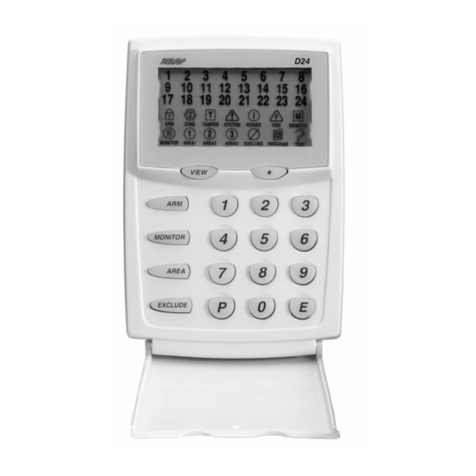
Ness
Ness D24 User manual

Ness
Ness M1 Cross Platform Control User manual
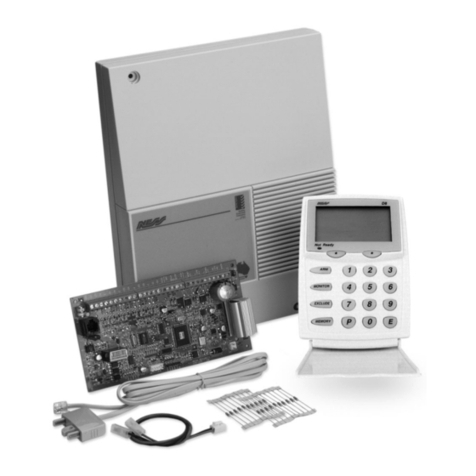
Ness
Ness D16 Assembly instructions
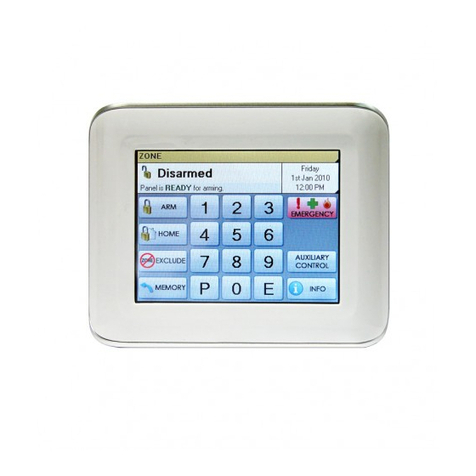
Ness
Ness D8X User manual
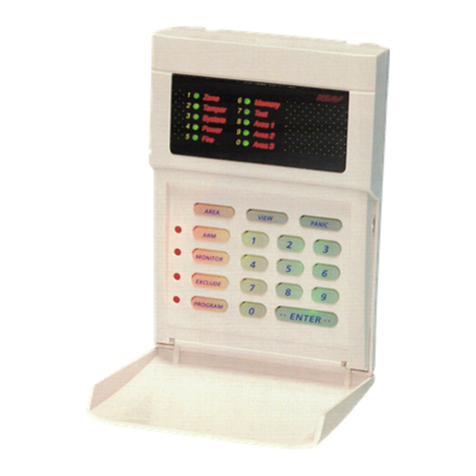
Ness
Ness pro-lx User manual
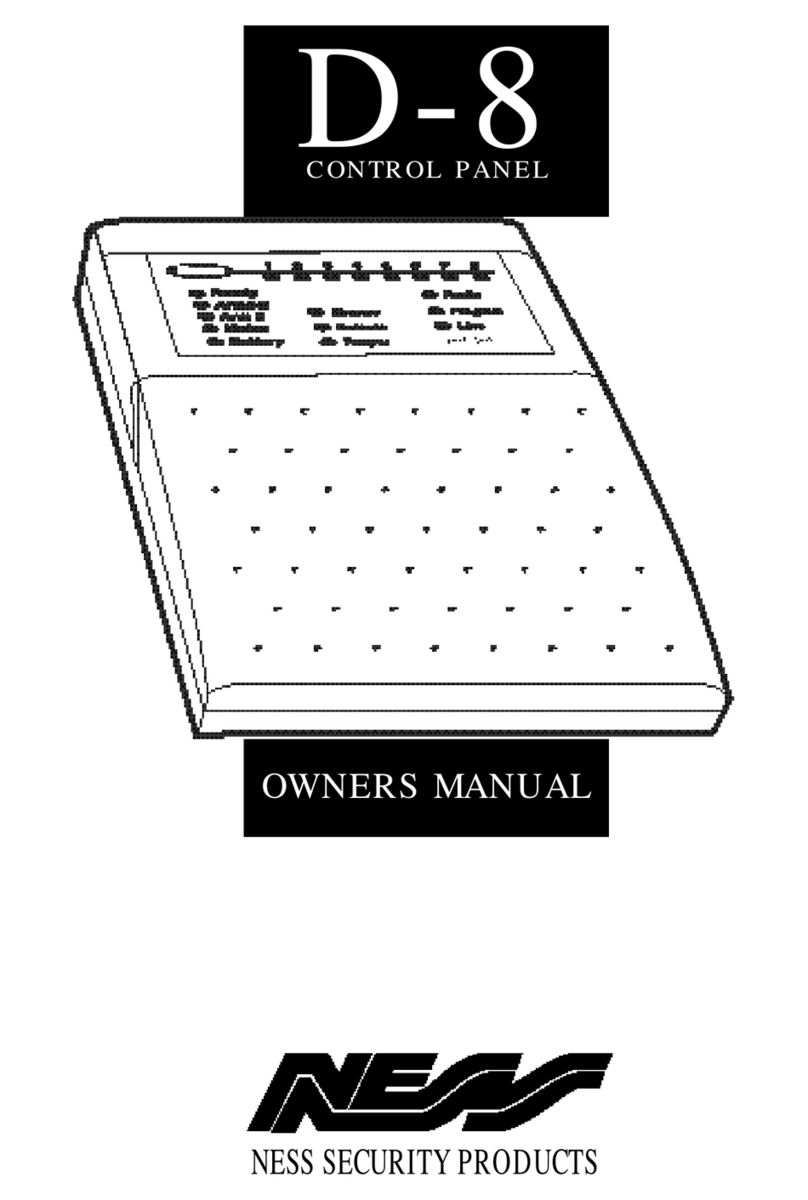
Ness
Ness D-8 User manual

Ness
Ness ECO8x Assembly instructions
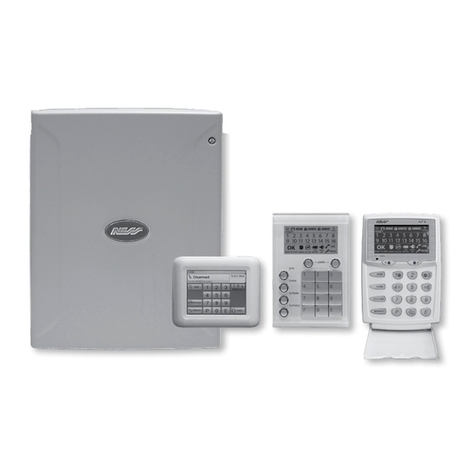
Ness
Ness D8xD User guide
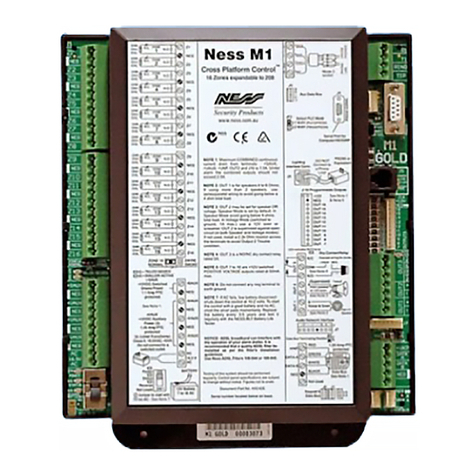
Ness
Ness M1 Navigator Instruction Manual

Ness
Ness D8X Assembly instructions
Popular Control Panel manuals by other brands
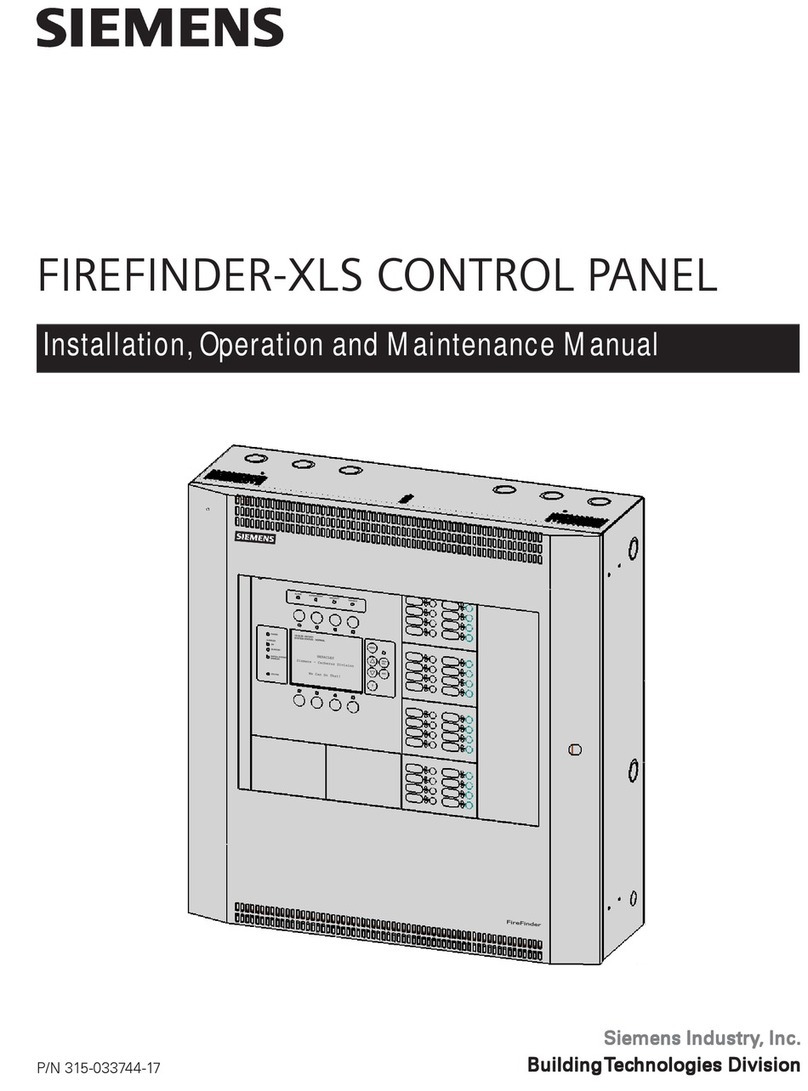
Siemens
Siemens FIREFINDER-XLS Installation, operation and maintenance manual
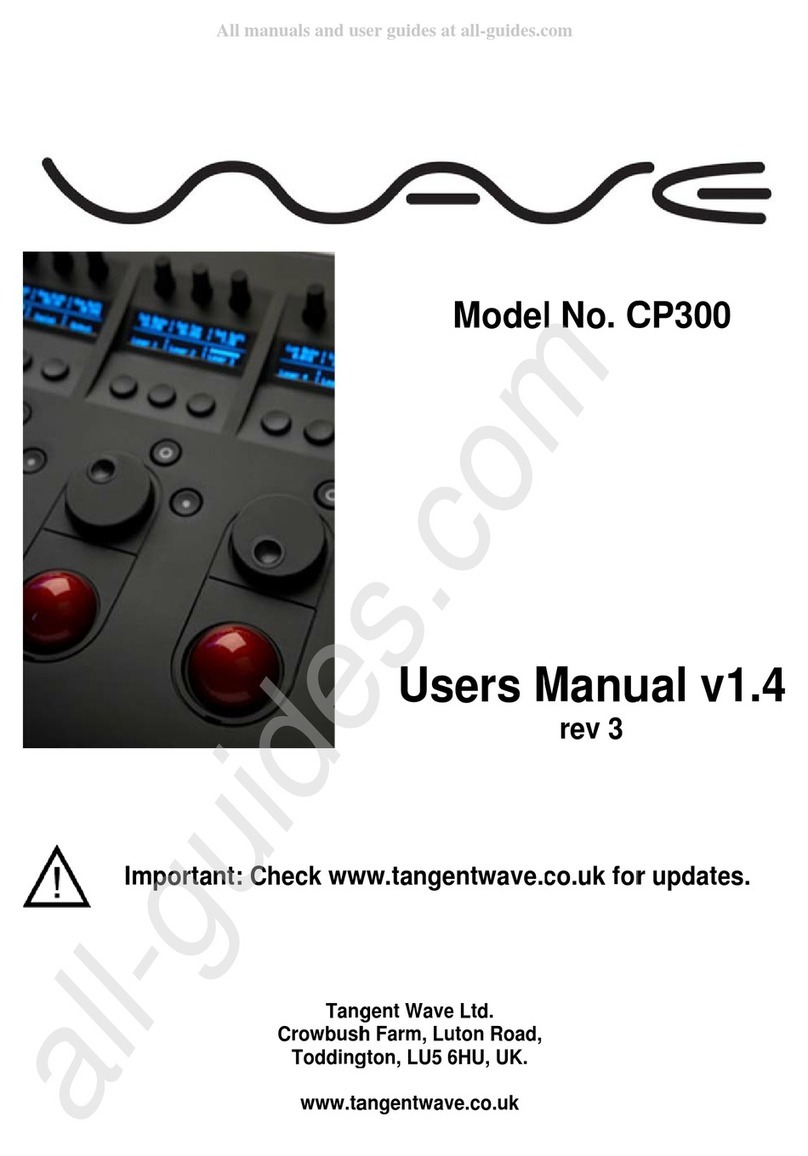
Tangent Wave
Tangent Wave CP300 user manual
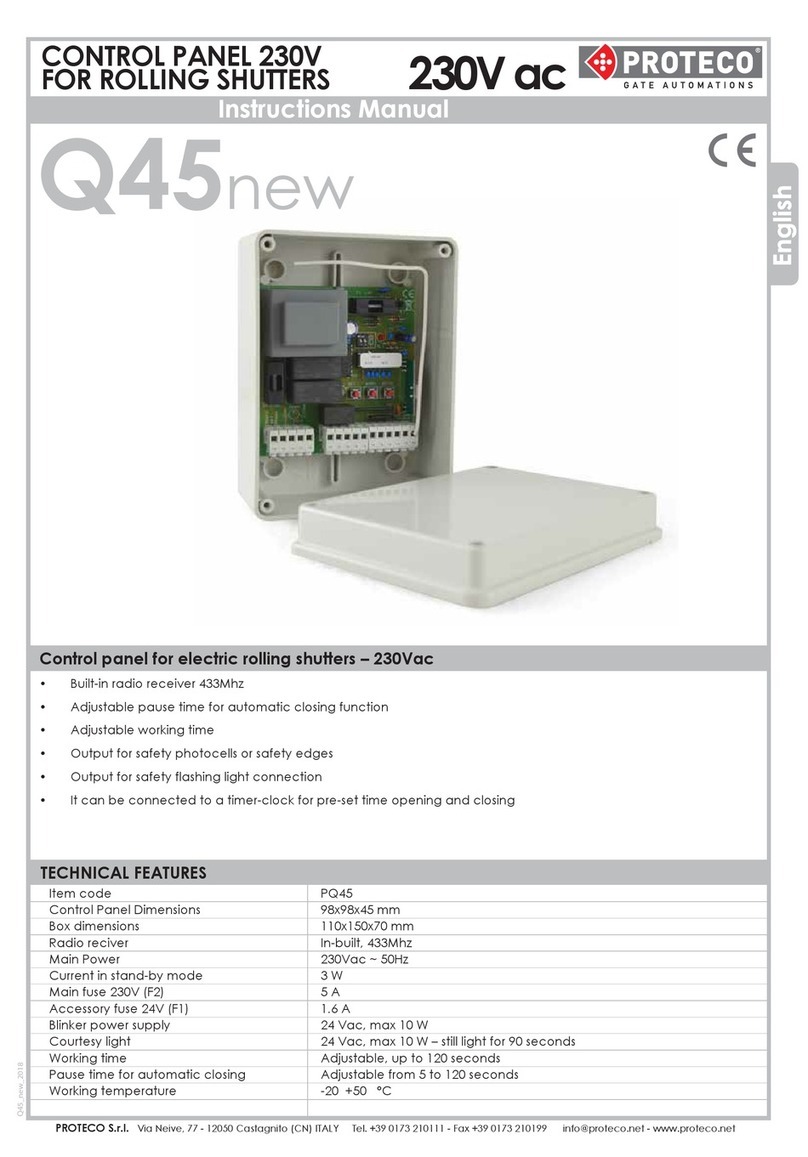
Proteco
Proteco Q45 new instruction manual

Viessmann
Viessmann Vitotronic 200 GW1 operating instructions

American Standard
American Standard NEXIA ACONT624AS42DA user guide

Nordelettronica
Nordelettronica NE274-TVDL instruction manual

